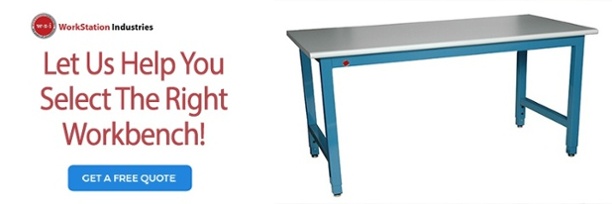Among the many scientific and high-tech pieces found in laboratories and manufacturing spaces today, there’s an often-overlooked element … the unassuming workbench stool.
Yet this seating spot that frequently blends into the background holds immense value in ensuring your team’s comfort, productivity and overall well-being.
More than just a place for sitting, stools for your bench play a crucial part in workspace design. When selecting the right stools for workbench spaces in your facility, your employees need these four features:
- Comfortable seating for enhanced productivity
- The right material for your workspace’s applications
- Mobility and stability for easy movement
- Accessories that add the right finishing touches
Comfortable Seating For Enhanced Productivity
The importance of comfort cannot be underestimated, as it can directly impact employees’ well-being.  affects their well-being and productivity. When selecting workbench stools, prioritize features that contribute to a comfortable seating experience.
affects their well-being and productivity. When selecting workbench stools, prioritize features that contribute to a comfortable seating experience.
In fact, poor posture over a long period of time can lead to health complaints like back pain, tension headaches and even slipped discs. According to the Bureau of Labor Statistics, approximately 32% of nonfatal injuries resulting in days away from work are treated in the emergency room. In 2019 (some of the most recently available data), musculoskeletal disorders accounted for more than 55% of ER visits.
The first aspect to consider is the design of the seat itself. Look for stools with ample padding and cushioning on the seat surface. High-quality foam or memory foam padding can help alleviate pressure points and ensure a comfortable sitting experience, even during extended periods of work.
Ergonomic considerations are also crucial when it comes to comfortable seating. Ergonomic chairs include features such as:
- Sturdy frames
- Adjustable heights
- Comfortable backrests and seats
Opt for workbench stools with contoured seats that align with the natural curves of the body. This design feature encourages proper posture, providing support to the lower back and preventing strain on the spine.
Industrial furniture chairs and stools can also come with backrests and armrests. Backrests offer additional support to the spine and help maintain a healthy posture throughout the day. Armrests provide a place for employees to rest their arms, reducing tension in the shoulders and neck.
The Right Material For Your Workspace’s Applications
Comfortable seating goes beyond the silhouette of a stool. It also encompasses the breathability of the materials used.
There are two considerations when choosing material:
- Comfort
- Safety
Breathable upholstery, such as mesh or fabric, can promote airflow and prevent heat buildup. This ensures a cooler and more comfortable seating experience, even in high-temperature work environments.
Yet in laboratories and industrial settings where safety is a concern, the material you choose can play an important role in maintaining safe operational procedures. There are typically three options that are used in labs and industrial applications today:
- Fabric
- Vinyl
- Polyurethane
Fabric is likely to be the material of choice for comfort, but it doesn’t stand up to the wear and tear of conditions where chemicals and other harsh substances are present. On the other hand, vinyl offers more resistance to stains, is easier to clean and more durable.
Another option is polyurethane. This tough material is synthetic and holds up well against harsh conditions and offers resistance to chemicals, oils and solvents. Its smooth and sleek surface is also easy to clean, yet is resistant to punctures and tears.
If you operate in a facility where static electricity poses a danger, it’s important to choose an ESD chair or stool that offers some protection. Static discharge can ignite flammable mixtures or vapors, as well as damage electronic components. Static electricity can even attract contaminants in clean environments.
Mobility And Stability For Easy Movement
As anyone working in a lab or manufacturing space knows, work doesn’t always stay in one spot. A well- designed workbench stool should provide easy movement and reliable stability, allowing employees to navigate their workspace with ease while ensuring their safety during various tasks.
designed workbench stool should provide easy movement and reliable stability, allowing employees to navigate their workspace with ease while ensuring their safety during various tasks.
One key feature that enhances mobility are casters or wheels. Casters enable effortless movement, allowing employees to move across a workspace without the need for constant standing and repositioning.
When incorporating casters into workbench stools, make sure the casters have the ability to lock in place. In busy laboratory or manufacturing environments, accidental movements or unintended rolling of stools can pose safety hazards. Workbench stools equipped with locking casters provide the flexibility to move when needed but can be securely locked into place when stability is required.
It’s important to carefully consider the quality and durability of both the casters and locking mechanisms as well. Casters should be able to support the weight of any of your employees, and reliable locking mechanisms should be easy to engage and disengage.
Accessories That Add The Right Finishing Touches
When designing a stool for your workbench, sometimes the smallest details can make the biggest difference. While comfort, material and the option of mobility are all important features to consider, here are a few additional accessories and products that can add the right finishing touches to your design.
Swivel functionality: Workbench stools with a swivel feature allow employees to rotate and access different areas of their workstations without straining or overreaching. This feature not only enhances convenience, but also plays a role in making a stool ergonomically-friendly.
Footrests: Including a footrest on the workbench stool can help alleviate pressure on the legs and improve blood circulation. This feature also allows employees to rest their feet comfortably and maintain a proper sitting posture.
Height and tilt adjustment: In addition to ensuring a stool’s height can be adjusted by the user, consider adding tilt adjustment mechanisms as well. The ability to tilt the seat and backrest can provide further customization options for workers to find their preferred sitting angle.
Tool and equipment storage: Depending on the nature of the work, having storage options attached to a workbench stool can offer convenience and greater productivity. Accessories like tool trays or pockets can provide a handy space for storing frequently used items and personal belongings.
Cup holder or utility trays: To further optimize functionality, consider accessories like cup holders or utility trays that can provide a convenient place to hold beverages, small tools or other items.
Lighting attachments: Attachable LED lights or task lights can be mounted onto the workbench stool, providing focused illumination for detailed work or when additional light sources are needed.
To ensure you have many of these customization options available to you, it’s important to work with an experienced and reputable industrial furniture company or manufacturer that prioritizes the needs of its customers. The right partner will work with you to make sure the exact needs of your order are met, that safety is emphasized in your design and any ideas you have come to life.


